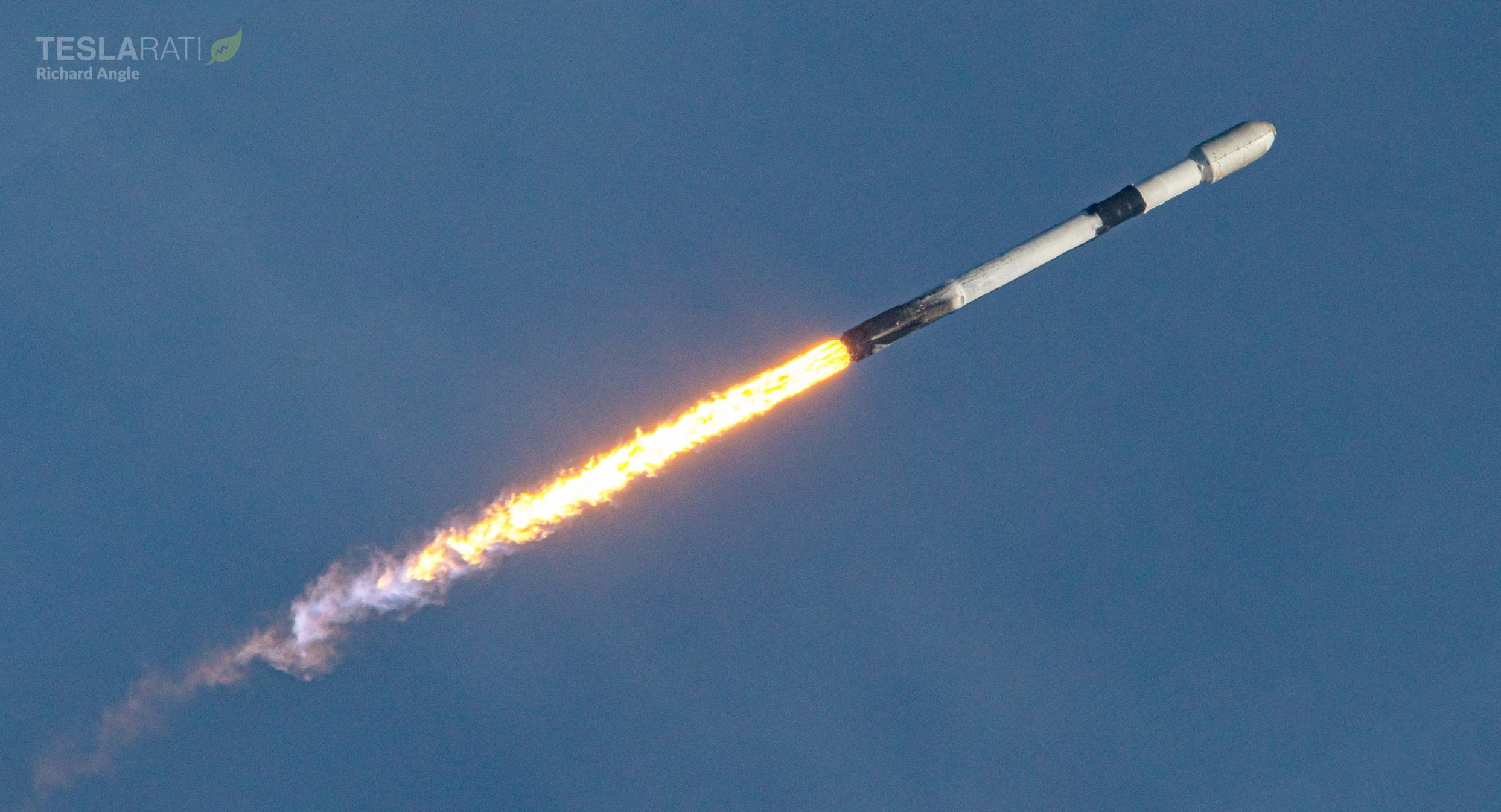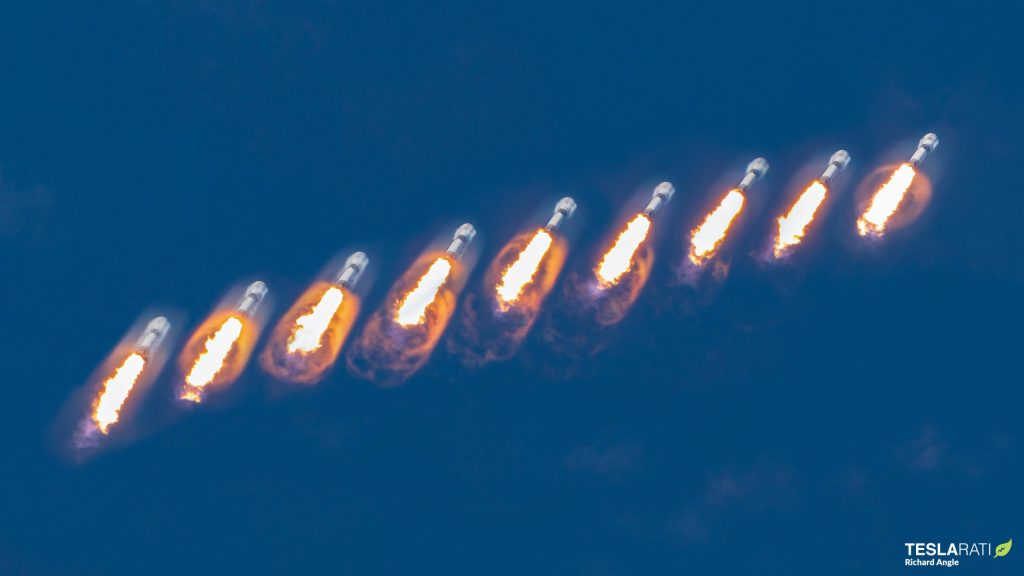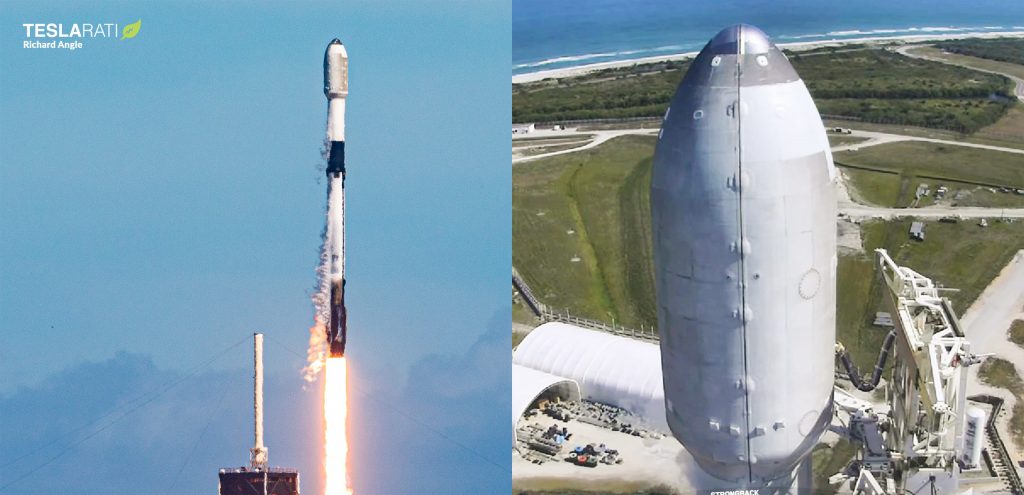

News
SpaceX launches third Falcon 9 rocket in 72 hours, breaks fairing reuse record
In one fell swoop, SpaceX has successfully launched the third Falcon 9 rocket in less than 72 hours, broken payload fairing reusability record, and placed the 2000th operational Starlink satellite in orbit.
After a string of delays from January 29th to February 2nd, Falcon 9 finally lifted off at 1:13 pm EST (18:13 UTC), February 3rd with the seventh batch of Starlink V1.5 satellites on a mission coincidentally known as Starlink 4-7. Falcon 9 booster B1061 completed its sixth spaceflight and orbital-class launch without issue, successfully sending an expendable Falcon upper stage and Starlink payload on their way to orbit and touching down on drone ship A Shortfall of Gravitas (ASOG) about nine minutes after liftoff.
While one of the rocket’s two fairing (nosecone) halves flew for the fourth time, the other half completed its sixth launch – a new record for fairing reusability approximately 27 months after SpaceX’s first fairing reuse. The record-breaking half likely last supported Starlink V1 L28 in May 2021. A separate half also flew for the fifth time and was recovered in January 2022. In comparison, it took SpaceX 32 months after the first Falcon booster reuse (March 2017) to launch the same booster for the fourth time and 41 months for the sixth time, highlighting both SpaceX’s growing expertise and how much easier reusing a fairing is relative to a rocket’s entire first stage.

With any luck, both Starlink 4-7 fairing halves will have successfully reentered Earth’s atmosphere, deployed GPS-guided parafoils, gently splashed down in the Atlantic Ocean, and been fished out of the water by a SpaceX recovery ship. SpaceX has never discussed its fairing reusability goals, so it’s unknown how many flights each half is nominally designed to support.
Inside that record-breaking fairing was the latest batch of 49 Starlink V1.5 satellites, which weigh about 30-40 kg (65-90 lb) heavier than Starlink V1 satellites and are mainly set apart by the addition of several laser links. Once enough laser-linked satellites are launched, SpaceX will be able to route user communications through space, precluding the need for a ground station to always be within line of sight of each satellite node. Aside from allowing Starlink to serve exceptionally remote users, laser links will also allow Starlink to break into the multi-billion-dollar aviation and maritime communications markets.

With Starlink 4-7, SpaceX has now launched 351 Starlink V1.5 satellites, 349 of which are likely functional and about 50 of which have already reached operational orbits. The mission also included the 2000th operational Starlink satellite launched by SpaceX since November 2019, likely raising the number of working Starlink satellites in orbit to just shy of 1900 (of 2016 total).
Starlink 4-7 was SpaceX’s sixth launch of 2022 less than five weeks into the year and the third successful Falcon 9 launch in 67 hours – a feat of launch cadence that only one other rocket family in history (Russia’s R-7 family) has achieved. SpaceX may have as many as 46 more Falcon launches planned this year.

News
Tesla is not sparing any expense in ensuring the Cybercab is safe
Images shared by the longtime watcher showed 16 Cybercab prototypes parked near Giga Texas’ dedicated crash test facility.

The Tesla Cybercab could very well be the safest taxi on the road when it is released and deployed for public use. This was, at least, hinted at by the intensive safety tests that Tesla seems to be putting the autonomous two-seater through at its Giga Texas crash test facility.
Intensive crash tests
As per recent images from longtime Giga Texas watcher and drone operator Joe Tegtmeyer, Tesla seems to be very busy crash testing Cybercab units. Images shared by the longtime watcher showed 16 Cybercab prototypes parked near Giga Texas’ dedicated crash test facility just before the holidays.
Tegtmeyer’s aerial photos showed the prototypes clustered outside the factory’s testing building. Some uncovered Cybercabs showed notable damage and one even had its airbags engaged. With Cybercab production expected to start in about 130 days, it appears that Tesla is very busy ensuring that its autonomous two-seater ends up becoming the safest taxi on public roads.
Prioritizing safety
With no human driver controls, the Cybercab demands exceptional active and passive safety systems to protect occupants in any scenario. Considering Tesla’s reputation, it is then understandable that the company seems to be sparing no expense in ensuring that the Cybercab is as safe as possible.
Tesla’s focus on safety was recently highlighted when the Cybertruck achieved a Top Safety Pick+ rating from the Insurance Institute for Highway Safety (IIHS). This was a notable victory for the Cybertruck as critics have long claimed that the vehicle will be one of, if not the, most unsafe truck on the road due to its appearance. The vehicle’s Top Safety Pick+ rating, if any, simply proved that Tesla never neglects to make its cars as safe as possible, and that definitely includes the Cybercab.
Elon Musk
Tesla’s Elon Musk gives timeframe for FSD’s release in UAE
Provided that Musk’s timeframe proves accurate, FSD would be able to start saturating the Middle East, starting with the UAE, next year.

Tesla CEO Elon Musk stated on Monday that Full Self-Driving (Supervised) could launch in the United Arab Emirates (UAE) as soon as January 2026.
Provided that Musk’s timeframe proves accurate, FSD would be able to start saturating the Middle East, starting with the UAE, next year.
Musk’s estimate
In a post on X, UAE-based political analyst Ahmed Sharif Al Amiri asked Musk when FSD would arrive in the country, quoting an earlier post where the CEO encouraged users to try out FSD for themselves. Musk responded directly to the analyst’s inquiry.
“Hopefully, next month,” Musk wrote. The exchange attracted a lot of attention, with numerous X users sharing their excitement at the idea of FSD being brought to a new country. FSD (Supervised), after all, would likely allow hands-off highway driving, urban navigation, and parking under driver oversight in traffic-heavy cities such as Dubai and Abu Dhabi.
Musk’s comments about FSD’s arrival in the UAE were posted following his visit to the Middle Eastern country. Over the weekend, images were shared online of Musk meeting with UAE Defense Minister, Deputy Prime Minister, and Dubai Crown Prince HH Sheikh Hamdan bin Mohammed. Musk also posted a supportive message about the country, posting “UAE rocks!” on X.
FSD recognition
FSD has been getting quite a lot of support from foreign media outlets. FSD (Supervised) earned high marks from Germany’s largest car magazine, Auto Bild, during a test in Berlin’s challenging urban environment. The demonstration highlighted the system’s ability to handle dense traffic, construction sites, pedestrian crossings, and narrow streets with smooth, confident decision-making.
Journalist Robin Hornig was particularly struck by FSD’s superior perception and tireless attention, stating: “Tesla FSD Supervised sees more than I do. It doesn’t get distracted and never gets tired. I like to think I’m a good driver, but I can’t match this system’s all-around vision. It’s at its best when both work together: my experience and the Tesla’s constant attention.” Only one intervention was needed when the system misread a route, showcasing its maturity while relying on vision-only sensors and over-the-air learning.
News
Tesla quietly flexes FSD’s reliability amid Waymo blackout in San Francisco
“Tesla Robotaxis were unaffected by the SF power outage,” Musk wrote in his post.

Tesla highlighted its Full Self-Driving (Supervised) system’s robustness this week by sharing dashcam footage of a vehicle in FSD navigating pitch-black San Francisco streets during the city’s widespread power outage.
While Waymo’s robotaxis stalled and caused traffic jams, Tesla’s vision-only approach kept operating seamlessly without remote intervention. Elon Musk amplified the clip, highlighting the contrast between the two systems.
Tesla FSD handles total darkness
The @Tesla_AI account posted a video from a Model Y operating on FSD during San Francisco’s blackout. As could be seen in the video, streetlights, traffic signals, and surrounding illumination were completely out, but the vehicle drove confidently and cautiously, just like a proficient human driver.
Musk reposted the clip, adding context to reports of Waymo vehicles struggling in the same conditions. “Tesla Robotaxis were unaffected by the SF power outage,” Musk wrote in his post.
Musk and the Tesla AI team’s posts highlight the idea that FSD operates a lot like any experienced human driver. Since the system does not rely on a variety of sensors and a complicated symphony of factors, vehicles could technically navigate challenging circumstances as they emerge. This definitely seemed to be the case in San Francisco.
Waymo’s blackout struggles
Waymo faced scrutiny after multiple self-driving Jaguar I-PACE taxis stopped functioning during the blackout, blocking lanes, causing traffic jams, and requiring manual retrieval. Videos shared during the power outage showed fleets of Waymo vehicles just stopping in the middle of the road, seemingly confused about what to do when the lights go out.
In a comment, Waymo stated that its vehicles treat nonfunctional signals as four-way stops, but “the sheer scale of the outage led to instances where vehicles remained stationary longer than usual to confirm the state of the affected intersections. This contributed to traffic friction during the height of the congestion.”
A company spokesperson also shared some thoughts about the incidents. “Yesterday’s power outage was a widespread event that caused gridlock across San Francisco, with non-functioning traffic signals and transit disruptions. While the failure of the utility infrastructure was significant, we are committed to ensuring our technology adjusts to traffic flow during such events,” the Waymo spokesperson stated, adding that it is “focused on rapidly integrating the lessons learned from this event, and are committed to earning and maintaining the trust of the communities we serve every day.”








